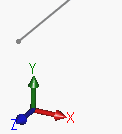I think the way to go about this is to create a separate Scene for the indicator and update its view matrix based on the parent plot.
With an LScene (using some 3d camera) this involves reading out eyeposition, lookat and upvector, moving lookat to 0 and adjusting eyeposition to a comfortable zoom level:
# Your plot
fig = Figure()
lscene = LScene(fig[1,1])
p = scatter!(rand(Point3f, 10))
display(fig)
scene = Scene(
fig.scene, px_area = Rect2f(20, 20, 100, 100),
# backgroundcolor = RGBAf(1,1,0), clear = true # to see scene region
);
linesegments!(scene,
Point3f[(0,0,0), (1,0,0), (0,0,0), (0,1,0), (0,0,0), (0,0,1)],
color = [:red, :red, :green, :green, :blue, :blue],
linewidth = 10
)
cam = cameracontrols(lscene.scene)
scene.camera.projection[] = Makie.perspectiveprojection(45f0, 1f0, 0.01f0, 100f0)
onany(cam.lookat, cam.eyeposition, cam.upvector) do lookat, eyepos, up
viewdir = 4f0 * normalize(eyepos - lookat)
scene.camera.view[] = Makie.lookat(viewdir, Vec3f(0), up)
return
endWith an Axis3 you need to read out the relevant angles and calculate eyeposition from that:
fig = Figure()
ax = Axis3(fig[1,1])
p = scatter!(ax, rand(Point3f, 10))
display(fig)
scene = Scene(
fig.scene, px_area = Rect2f(20, 20, 100, 100),
backgroundcolor = RGBAf(1,1,0), clear = true # to see scene region
);
linesegments!(scene,
Point3f[(0,0,0), (1,0,0), (0,0,0), (0,1,0), (0,0,0), (0,0,1)],
color = [:red, :red, :green, :green, :blue, :blue],
linewidth = 10
)
scene.camera.projection[] = Makie.perspectiveprojection(45f0, 1f0, 0.01f0, 100f0)
onany(ax.elevation, ax.azimuth) do theta, phi
viewdir = 4f0 * Vec3f(cos(theta) * cos(phi), cos(theta) * sin(phi), sin(theta))
scene.camera.view[] = Makie.lookat(viewdir, Vec3f(0), Vec3f(0,0,1))
return
end

It is common in 3D CAD software to have a reference frame displayed in the picture
e.g. this in CATIA Solidworks
Solidworks

It's fairly obvious that one can reproduce that in GLMakie with arrows, however, it can't figure how to have the arrow origin remain fixed in pixel space. Is there a way to achieve this. I'm guessing something quite equivalent to the
:pixeoftextwould be nice. The arrow should however rotate according to the:dataspace and the camera angles